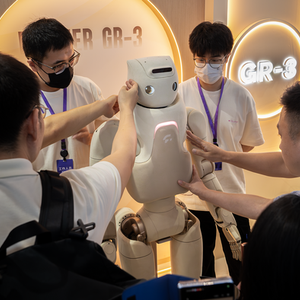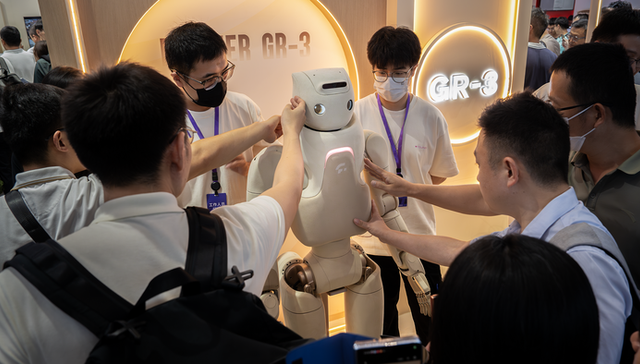by LI Biao
From August 8 to 12, the 2025 World Robot Conference took over the Yizhuang International Exhibition Centre in Beijing, drawing record participation despite steady summer rain. On opening day, visitors queued for nearly two kilometres to be among the first to see the machines in action.
The scale was unprecedented: more than 200 domestic and international firms showcased over 1,500 robots, the largest display in the event's history. Fifty of the exhibitors specialised in humanoid robots — also a record for a robotics fair in China. Inside, crowds pressed against the demonstration stages, while four-legged robotic dogs wandered among them.
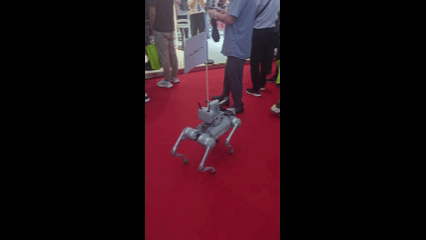
One such "dog", built by Galbot, was fitted with a vision-language-action (VLA) model — technology that combines visual, linguistic and motion recognition — and additional sensors to enable untethered, fully automated target-following, even in dense crowds.
From spectacle to skill
If 2024's emphasis was on dramatic stunts, this year's exhibitors made their robots move with purpose. Demonstrations ranged from boxing and football to warehouse sorting and bar service. Booster Robotics, fresh from co-hosting a humanoid boxing tournament with CCTV in May, rebuilt the ring on site. Its 1.3-metre-tall, 32kg G1 robots, split into red and green "fighters", exchanged jabs and kicks under human control, recovering balance after blows and rising smoothly from the floor. Visitors were invited to spar with them.
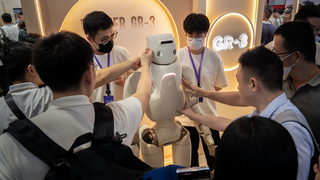

Booster Robotics also drew crowds to its mini football pitch, where 1.2-metre Booster T1 robots dribbled, tackled and scored in 2-on-2 matches. Other firms took a showbiz turn: EngineAI's "Iron Man" performed street dance; MagicLab paired humanoids with quadrupeds in synchronised routines; Robotera's full-sized L7 executed a 360-degree aerial jump; and AI2Robotics' Alpha Bot drummed on stage.
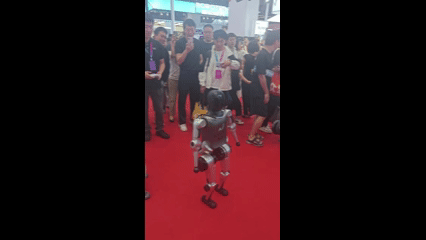
Stability was another headline feature. Neotix Robotics' founder, JIANG Zheyuan, repeatedly kicked his company's N2 robot from behind — it stayed upright each time, or recovered quickly when pushed over. LimX Dynamics let visitors shove its two-wheeled model up to a metre away; it righted itself within seconds. Other advances included Lumos Robotics' humanoid that could spring upright in one second and lift 50kg, and UBTECH's Walker S2, capable of autonomous battery swaps in three minutes for round-the-clock operation.
Searching for real work
A more striking shift came in the staging. After months of industry debate about whether "showboating" robots could be genuinely useful, many exhibitors built mock workplaces to illustrate potential deployment. Robotera demonstrated two L7 robots on a parcel-sorting line — one identifying and classifying packages by size, shape and weight, the other scanning barcodes — powered by its own ERA-42 VLA model, which learns new tasks from small data sets without pre-programming.
Fourier unveiled its GR3 rehabilitation humanoid, launched earlier this week. Standing 1.65 metres tall and weighing 71kg, it is covered in soft composite fabric and bears a rounded, friendly appearance reminiscent of Baymax from Disney-Marvel's Big Hero 6. The company aims to deploy it in cognitive training and patient guidance in rehab hospitals, before expanding to community care and elderly facilities. "Compared with putting a robot in every household, professional settings such as factories and hospitals are the nearer-term focus," founder and CEO GU Jie told Jiemian News, noting that medical care is a vast market, with rehabilitation just one entry point.

Keenon Robotics CEO LI Tong said his company is targeting specific roles rather than chasing the all-purpose humanoid. The firm's XMAN-R1, on show at the conference, can mix cocktails or make coffee. "Looking for deployment scenarios means focusing on defined positions like bartenders, so we can achieve commercialisation in simpler functional environments first," he said.
Industry leaders agree that industrial, logistics, retail, and medical care are currently the most promising domains. UBS forecasts that humanoid robot numbers could exceed two million worldwide by 2035, with manufacturing leading adoption, particularly in automotive plants shifting from mechanical arms to humanoid forms.
"Pre-ChatGPT" moment
Unitree founder WANG Xingxing told the main forum that the sector's ultimate goal is "to get robots to work", likening the current stage to "one to three years before ChatGPT's release." He said demand has surged in China this year, with both manufacturers and component suppliers seeing 50–100 per cent sales growth in the first half of 2025, driven by policy support and public interest.
In the next two to five years, WANG predicted, the industry will focus on three fronts: unified end-to-end embodied AI models for humanoids; cheaper, longer-lasting hardware for mass production; and distributed, low-cost computing power.
